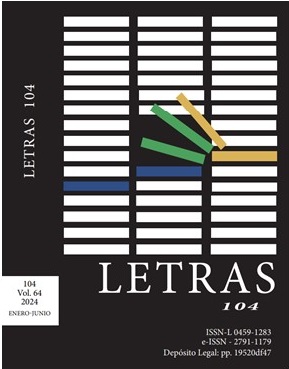Lilith, the first femme fatale: Literary and cinematographic stereotypes
DOI:
https://doi.org/10.56219/letras.v64i104.3035Keywords:
Lilith, Femme Fatale, vamps, cinema, literatureAbstract
The term "Femme Fatale" began to resonate metaphorically after the release of the film A Foll There Was (1915), featuring the character portrayed by actress Theda Bara. This character epitomized an ambitious, dangerous, and captivating woman, a portrayal that cemented the archetypal image of the femme fatale. This archetype evolved significantly over time, diverging from its biblical progenitor, Lilith, the Judeo-Babylonian Goddess of the Night. The purpose of this paper is to identify the archetype of Lilith in cultural products offered by literature and cinema. We employed the hermeneutic method, focusing on the comparison and interpretation of the physical and psychological traits of fictional characters with those of the mythological Lilith and their corresponding narratives. We reviewed works such as *Carmilla* (1872) and *Dracula* (1897), comparing their characters with those in films featuring female vampires, such as Lilith from The Monster Family (1964) and Morticia from The Addams Family (1964), as well as the film The Hunger (1983). Additionally, legends that label real women as femmes fatales, such as the infamous spy Mata Hari, were examined. In conclusion, Lilith has been interpreted in various ways in both audiovisual and textual narratives. These interpretations, while retaining her fatalistic essence, have evolved from her original religious context. In her modern incarnations, Lilith continues to transgress norms and, in some cases, has become a symbol of feminine independence, as exemplified in the novel *Doña Bárbara* by Venezuelan writer Rómulo Gallegos.
Downloads
References
Cazón, A. (08 de septiembre de 2023). Camille Monfort, «La Vampira Amazona» https://horapicodigital.com.ar/index.php/2023/09/08/camille-monfort-la-vampira-amazona/
Chico-Álvarez, L. M. (2023). El Independiente. Https://www.elindependiente.com/tendencias/arte/2023/09/28/diosas-musas-brujas-y-santas-asi-ha-evolucionado-la-feminidad-a-lo-largo-de-la-historia-del-arte/#google_vignette
Colossians. (03 de febrero de 2023). Biblia Paralela. Https://bibliaparalela.com/colossians/3-18.htm
Dahl R. (1983). The Witches. (ed. 2002). Alfaguara.
González L, A. (2013). El mito de Lilith, evolución iconográfica y conceptual. Legado de Arquitectura y Diseño, 8 (14), pp. 105-114. Https://legadodearquitecturaydiseno.uaemex.mx/article/view/14247
Le Fanu, S. (1872) Carmilla. (ed. 2014). Libro al viento. Alcaldía de Bogotá.
León, F. (2016) Análisis hermenéutico de la mujer venezolana desde el arquetipo Doña Bárbara. Eleutheria, 2, (50), 1-21. Https://eleutheria.ufm.edu/wp-content/uploads/2022/11/160621_fleon_Donia_Barbara.pdf
Nájera, O. (2003). Lilith y Caín ¿Rebeldes o revelaciones? Revista Razón y Palabra, 35, 2-5. Https://dialnet.unirioja.es/servlet/articulo?Codigo=717640
San José, R. (2021) Origen del mito: Lilitu y Lillake. Revista Anual de Historia del Arte N°27
Sprenger, J. Y Kramer, H. (1486). Prólogo. Malleus Maleficarum Martillo de las Brujas. (Traduc. Floreal Maza.) Ediciones Orión. Recuperado 30-03-2024 de https://www.academia.edu/29758861/Malleus_Maleficarum_Martillo_de_las_Brujas
Stoker Bram (1897). Drácula. E Alejandría. Recuperado 30-03-2024 de https://www.elejandria.com/
Tardío, F. Y Serrano I. (2011) La mujer fatal. Revista Verba Hispánica; Liubliana Tomo 19, (1), 89-100. DOI: https://doi.org/10.4312/vh.19.1.89-100
Una isla de ideas (26 de mayo de 2022) “El ansia, 1983” https://unaisladeideas.com/cine-series/el-ansia/
Wikipedia.org. (30 marzo de 2024). Archivo: Lilith (John Collier painting).jpg. Recuperado 30-03-2024 de https://es.m.wikipedia.org/wiki/Archivo:Lilith_(John_Collier_painting).jpg
Published
How to Cite
Issue
Section
License
Copyright (c) 2024 LETRAS

This work is licensed under a Creative Commons Attribution-NonCommercial-ShareAlike 4.0 International License.
Letras magazine retains the patrimonial rights (copyright) of the published works, which favors and allows their reuse under the license (CC BY - NC - SA 4.0), for which they can be copied, used, disseminated, transmitted and expose publicly, as long as the authorship and original source of its publication (magazine, publisher, URL and DOI of the work) is cited, they are not used for commercial or onerous purposes and the existence and specifications of this use license are mentioned.















